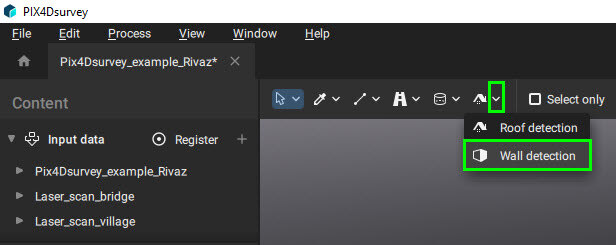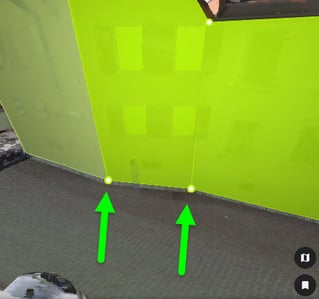Wall detection - PIX4Dsurvey
The Wall detection tool in PIX4Dsurvey allows for the automatic detection of wall surfaces and creates a polygon for every selected wall element. The algorithm uses the slope information and creates a planar polygon for every wall element selected. The color of the point cloud is not taken into account, allowing for the detection of walls with different colors or materials.

- On the toolbar, click the
 icon.
icon.
IN THIS ARTICLE
Definitions
How to use the wall detection tool
How to measure the wall polygons
Modify the wall polygons
Definitions
| Wall element | Seed point | Wall polygon |
|---|---|---|
|
A wall element is a part of a wall that can be described with a single plane. The image below shows four different walls elements. Note that the walls 1, 2, and 3 are not on the same plane. |
This point serves as a guide to tell PIX4Dsurvey where to start growing a polygon. The image below shows four seeds, one for each wall element. Every wall element must have at least one seed. |
For each seed, a planar wall polygon is created. If two seeds grow into the same polygon, this will become a single polygon. The image below shows the four created wall polygons, one for each wall element. |
|
|
|
|
How to use the wall detection tool
- Open a project in PIX4Dsurvey.
- (Optional) Go to the Layers tab in the Content sidebar and select a layer.
- The created polygons will be added to the selected layer.
- If no layer is selected (or a locked or invisible layer is selected), a new layer is created.
- Select the Wall detection tool
 from the toolbar.
from the toolbar.
- Left-click on a wall element in order to create seed points. One wall element can have more than one seed point.
- Right-click or press the Enter key to create the wall polygons.
- You can track the progress in the status center.
- If no wall is detected around a seed point, no wall polygon will be created around that seed.
- When possible, create seed points in flat areas with the least amount of noise.
- Avoid placing seed points very close to the edges.
- Sometimes multiple seed points need to be selected for a single wall element/plane, especially for very large planes and for planes with obstacles in between (other planes, such as balconies and windows, can also be seen as obstacles).
- When in doubt, select an extra seed point, and the algorithm will still merge them into a single plane when possible.

How to measure the wall polygons
Wall polygons are treated as standard polygons. To learn more about measurements on polygons, please visit this article: How to measure polygons.
Modify the wall polygons
Sometimes, wall polygons need to be slightly corrected. In these cases, it is possible to follow the standard procedure for geometry editing, as explained in the article Editing geometry in the 3D view.
PIX4Dsurvey's wall detection tool provides a powerful solution for efficiently detecting wall surfaces enhancing productivity, simplifying workflows, and enabling precise wall measurements, making it an indispensable asset for many use cases.



